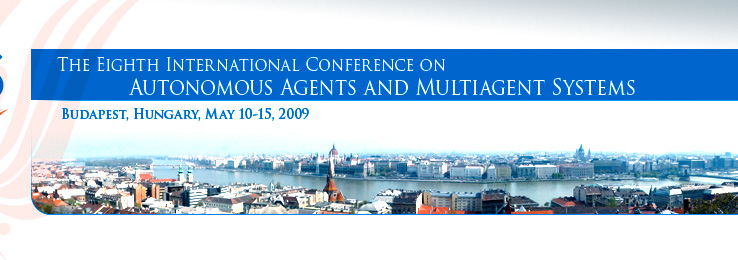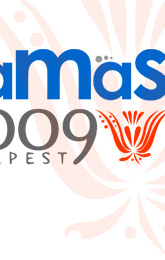| |
 |
 |
| SUBMISSION DETAILS |
SUBMISSIONS ARE CLOSED
This year the conference is soliciting regular papers (8 pages) and extended abstracts (2 pages). These limits include text, figures and references. Extended abstracts are encouraged as a mechanism for the timely reporting of interesting but preliminary work, that may not as yet have the level of evaluation or detail that would be expected for a regular paper. The program chairs may, at their discretion, accept papers that were submitted as regular papers as extended abstracts, if the authors have explicitly agreed to this when registering their papers.
Accepted regular papers will receive a slot for oral presentation in the conference. In addition, both regular and extended abstracts will be presented in poster sessions and appear in the conference proceedings.
Reviews will be double blind, therefore authors are requested to avoid including anything that can be used to reveal their identity. Submissions will be peer reviewed rigorously and evaluated on the basis of adherence, originality, soundness, significance, presentation, understanding of the state of the art, and overall quality of their technical contribution.
PAPER FORMATS
Both regular papers (max. 8 pages) and extended abstracts (max. 2 pages) should be formatted for standard Letter paper size. (i.e. not A4). Overlength papers will be rejected.
LaTeX Users
Regular papers
1. Please use this LaTeX2e style.
Here is an example file using this style.
It's a trivial modification of the ACM LaTeX style, with the AAMAS 2009 info and IFAAMAS copyright info inserted. The size of the copyright slug is only half the size of the original ACM style. If there are problems with the style file, please contact the publication chair, not ACM, as they will NOT give support for the modified style files.
2. Please use the 'abbrv' bibliography style. To do so, please insert the following line at the end of your document (before \end{document}) : \bibliographystyle{abbrv}
3. Please use Type 1 fonts for your .pdf file. Click here for help. If you still have difficulty check with your system administrator.
4. Format your document for American Letter paper (8-1/2x11): To ensure your submission is formatted for Letter paper, use \documentclass[letterpaper]{aamas2009} in your LaTeX file.
5. Note that we require the final final submission to be in .pdf format. We strongly recommend that you use pdflatex to typeset your paper since (a) it directly creates a .pdf file and (b) it uses Type 1 fonts by default. Should you choose to use latex, make sure you convert the resultant .dvi file to .pdf using either ghostscript or dvipdf.
Extended Abstracts
For extended abstracts submissions, the following style file should be used. It replaces every \subtitle command by the text: "(extended abstracts)" and adds information to the copyright info.
For additional information, you may also have a look at this example and the comments therein.
Word Users:
Regular papers
Please use this template for Word with the corresponding modification of the ACM style. If there are problems with the template, please contact the publication chair, not ACM, as ACM will NOT give support for the modified template.
Extended Abstracts
For extended abstracts submissions use this file as template. A subtitle "(extended abstracts)" as well as the necessary copyright information is added.
Other word processing software
Regular Papers
Follow this style description - again it describes the above mentioned small modification of the ACM style.
Extended Abstracts:
For extended abstracts submissions, follow the instructions in this style description. It corresponds to the style description of the full paper, except for a subtitle "(extended abstracts)" and more information in the copyright part.
REGISTERING AND UPLOADING PAPERS
As in previous years, the management of AAMAS 2009 will be done through Confmaster system.
Submissions will be accepted starting September 20, 2008.
Please notice that the electronic submission site is likely to be very busy around the paper submission deadline. You are strongly encouraged to submit your paper as far in advance of the deadline as possible.Notification of receipt of the electronic paper will be mailed to the first author (or designated author) soon after electronic abstract submission.
First Step: Electronic Abstract Submission
Authors are required to register their submission. In this first step, authors are required to do the following steps:
1. enter the title of the paper
2. select an inspiration source (please select Other if the proposed ones are not adequate)
3. select an description level (please select the most relevant one in
the case that a paper covers more than one option)
4. select the paper type (regular paper or extended abstract)
5. select a focus axis, which appears in Confmaster with the label "Keyword" (please select Other if the proposed subareas in each option of the selected axis are not adequate)
6. provide an abstract with at most 600 words
7. provide co-authors information (names and email addresses)
8. state whether the primary author is a student (if the answer is yes, the regular paper can be considered for the best student paper award)
9. state whether you accept that a regular paper could be accepted as an extended abstract
Electronic abstract submissions must be done before October 10, 2008 at 23:59 EDT (GMT-4).
Second Step: Electronic Paper Submission
After (or at the same time) the electronic abstract submission is made, authors are required to submit their electronic papers. The only formats allowed for electronic submission are PostScript or PDF
(Adobe's Portable Document Format), with a size limit of 5 MB. Papers will not be accepted in any other format.
Electronic paper submissions must arrive no later than October 14, 2008 at 23:59 EDT (GMT-4).
Submissions received after this date will not be considered for review.
DOUBLE BLIND REVIEW
AAMAS-09 will be double blind reviewed. In order to make this reviewing possible, authors should omit their names and affiliations from the paper. In place of their names and affiliations, they should provide the tracking number of the paper (ie the number that is assigned to the paper by the ConfMaster system when the paper is registered). Also, while the references should include all published literature relevant to the paper, including previous works of the authors, it should not include unpublished works. When referring to one's own work, use the third person rather than the first person. For example, say "Previously, Lesser [7] has shown that...", rather than "In our previous work [7] we have shown that...." Avoid including any information in the body of the paper or references that would identify the authors or their institutions. Such information can be added to the final camera-ready version for publication.
POLICY ON MULTIPLE SUBMISSIONS
AAMAS-09 will not accept any paper which, at the time of submission, is under review for or has already been published or accepted for publication in a journal or another conference. This also includes previous AAMAS workshops with post-proceedings publications and/or short papers in previous AAMAS proceedings, unless the authors *clearly* demonstrate significant new content with respect to the previous publication.
Authors are also expected not to submit their papers elsewhere during the AAMAS review period. These restrictions apply only to journals and conferences, not to workshops and similar specialized presentations with a limited audience and no formal proceedings.
REVIEWING PROCESS
A Senior Program Committee member will be in charge of supervising the review process of each paper. Three Program Committee members will review each paper. Selection criteria include accuracy and originality of ideas, clarity and significance of results and quality of the presentation.
Furthermore, each major option along each of the three axes has been assigned to two Area Chairs. The duty of these Area Chairs is to carefully reconsider papers in their respective "slice" of the 3D space, especially borderline papers or papers with highly divergent reviews. Thus every paper, as a point in 3-space, will have three final checks that the decision and review process for the paper was fair and reasonable. In any case, decision of the Program Committee Chairs will be final and cannot be appealed.
Notification of acceptance or rejection of submitted papers will be mailed to the first author (or designated author) by December 19, 2008, and
camera ready version of the accepted regular papers and extended abstracts are due to February 6, 2009.
Note that at least one author of each accepted paper is required to register and to attend the conference to present their work.
|
|
| |
|
|



